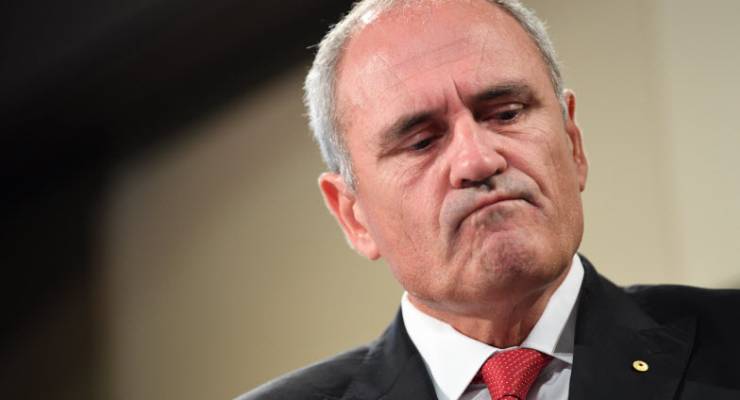
While NAB chairman Ken Henry garnered plenty of attention with his claims about the impact of the government’s bank tax on financial stability, the line from the banks about systemic risk — which features strongly in their submission Treasury on the tax — is rubbish.
In a sign the banks consulted each other on a common position, they all argued the tax would work against efforts of lenders to build up more liquid, or easy-to-sell assets, designed to help banks cope through a period of turmoil.
Except, it won’t.
Since the global financial crisis, banks have been forced to hold enough assets to enable them to stay open for business during a 30-day period of financial stress. In late 2008, in the wake of the collapse of Lehman Brothers, the banks needed of tens of billions of dollars in emergency funding from the Reserve Bank, government guarantees of bank deposits up to $250,000, and a three year guarantee on bank debt raisings to stave off any risk of collapse. Now, as part of a commitment to making Australia’s banks “unquestionably strong” (the central recommendation of the Murray Inquiry), regulators require that banks hold sufficient capital buffers to survive 30 days. That means holding enough high-quality assets (such as Commonwealth Government bonds) that could be easily sold to cover any short-term outflows.
But the big banks’ submissions to Treasury all claim the tax would work against this goal. Take Commonwealth chief executive Ian Narev, who warned that the CBA used debt to fund its purchase of high-quality liquid assets. The tax would make it more expensive to fund these assets because it would apply to debt issued by the bank. “The levy creates disincentives for banks to build liquidity and funding buffers, a critical part of being ‘unquestionably strong’,” Narev wrote. The ANZ and NAB mounted similar arguments.
But regulators led by the Reserve Bank have set up a system that will make sure those liquid assets are available. In 2011, the RBA announced it was setting up a Committed Liquid Facility (CLF) so that banks will “have enough access to liquidity to respond to an acute stress scenario.” The problem is, the banks don’t like it because it requires them to structure their assets in a way that is financially uncomfortable and involves paying commitment fees of hundreds of millions of dollars a year to the central bank. And if there is one bank they hate paying money to its the Reserve Bank.
The Australian Prudential Regulatory Authority (APRA) and the RBA set up the CLF to provide a liquidity backstop for the 13 major banks or Authorised Deposit-Taking Institutions (ADIs). The ADIs have to estimate how much liquidity they will need to keep themselves open and running for a 30 day period; the regulators assess that, approve it, or ask for changes, and once agreed, the 13 ADIs pay a commitment fee of 0.15% a year. They have to hold assets on their balance sheets equal to their individual CLFs so that if a crisis hit they can be sold to the RBA for cash to stave off any funding crisis.
In 2015, the total amount of CLF available was $275 billion. In 2016 it was cut to $245 billion and in 2017 year it will be $223 billion; it will probably fall to around $190 billion for 2018. That’s because the Commonwealth is making more and more debt available, via Commonwealth Government Securities, as it continues to blow out the deficit. The banks snap that up every time there is a new issue because that means they can reduce their CLF assets and reduce the fee they pay to the RBA. On $223 billion, the 13 ADIs would have to pay around $335 million this year.
The chances of the CLF disappearing altogether are low, because later this year the banks will find out how much extra capital they will have to make their balance sheets even stronger (especially the amount of capital held against housing loans, which will rise following the investor boom).
So the banks know the CLF will be there as a backstop. But they hate being forced to hold tens of billions of dollars of high quality assets for the CLF, and they resent paying the commitment fee to the RBA. The new tax means they’ll be able to buy fewer bonds — which will attract the levy — than otherwise, meaning they’re stuck with greater CLF assets than they would prefer.
But will it have any impact on their stability or capacity to stay standing in the event of a crisis? No — they’ll have the assets either way.








Enough lies indeed. Get the Royal Commission going.
NAB chairman Ken Henry calls for public inquiry into Turnbull Government’s $6.2 billion bank tax.
I would go further Ken; let’s have a royal commission
I’m assuming you mean a royal commission into banking profits, cartels and price fixing?
Henry v Turnbull …. mmmmmm?
Meanwhile governments around the world have been mismanaging their economies – and whacking their banks for change, to make up for their incompetence and self-indulgences?
Who’s supposed to have been “regulating” the banks?
Quite a few technical errors in your argument there Glenn, but I’ll grant you it is a complicated subject area.
With Talcum producing a Labor-lite Budget and the UK’s PM committing to Butskellist socialism with council housing & workers’ rights (shock horror from the backwoods squireocracy), can it be long before the obvious cure for usurious banks is implemented, one that is government owned?
It could be called something like, I dunno, the Bank of Common Weal?